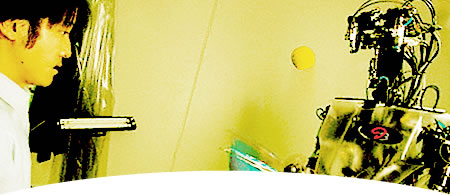
The VIA Robotics
Initiative
The VIA Robotics Initiative is part of a greater effort
in 2003 for VIA to participate within the robotics community,
and to explore innovative new applications for VIA's "Total
Connectivity" vision. VIA sees massive potential for growth in
the robotics space through close cooperation between the
software, hardware and mechanical engineering communities and
the establishment of open development standards. The VIA
Robotics Initiative is the first step by VIA to join in that
cooperation and take on a leadership role in enabling the
creation of highly integrated, low power, and open x86
platforms that will help drive future robotics innovation.
Robotics Today
The
maturation of key PC industry technologies, notably wireless
networking and continued reductions in form factor and costs,
is making it possible for robotics to begin to realize its
full potential in commercial as well as industrial, space, and
military environments. Efforts are also being made to create
open and standard software implementations for key robotic
control functions. Software projects like The OROCOS (Open Robotic Control
Software) Project aim to further promote the widespread
development for robot projects and business opportunities.
The Right Robotics
Development Platform
With
our highly acclaimed VIA EPIA Mini-ITX mainboard series, VIA
is able to offer an unrivaled range of highly integrated, low
power, x86 platforms that are ideal for robotics designs.
Available in a variety of processor speeds of up to 1GHz and
packing in full set of advanced connectivity and digital media
features, VIA EPIA Mini-ITX platforms deliver proven
performance and functionality on a tiny, low power 17cm x 17cm
footprint that can be integrated into highly compact
enclosures.
 |
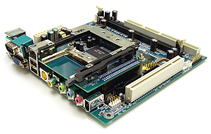 |
The native x86 environment of the VIA EPIA Mini-ITX
also provides a mature software development platform for both
Microsoft Windows?and a variety of Linux operating systems,
enabling the rapid and affordable implementation of new
robotics applications. The VIA EPIA Mini-ITX also has an
aggressive roadmap of new products, which include features
such as dual LAN support, integrated compact flash and Card
Bus, higher processing speeds and lower power and fan
requirements. The rapidly evolving feature set of the VIA EPIA
Mini-ITX will continue to expand the range of options and
platforms suited for different autonomous vehicle and robotics
applications.
VIA Technologies and Robotics
Projects
As
part of VIA's leadership role in robotics we are working
closely with academic and institutional projects that
demonstrate the vision and capabilities in robotics and how
robots deal with key issues such as navigation, mobility and
design. Two such examples include:
SRI
International Centibots Project
This is a joint project
with Stanford, University of Washington, and ActiveMedia
Robotics, to design, implement and demonstrate a computational
framework for the coordination of very large robot teams,
consisting of at least 100 small, resource limited robots, on
indoor reconnaissance tasks including mapping, tracking and
guarding. The Centibots project is primarily funded by Defense
Advanced Research Projects Agency in an effort to develop new
technologies for urban surveillance through distributed
robotics. The "Amigobots" are equipped with VIA EPIA 5000
Mini-ITX mainboards.
Ventures such as the Centibots project will have a far
reaching influence on the way potentially dangerous tasks are
handled such as bomb disposal, intruder detection, hostage or
military actions, hazardous waste exposure and disposal, and
searching earthquake, fire or chemically damaged sites -
essentially any perilous complex task that presently might
risk human lives.
The Centibot project robots operate autonomously, can
intercommunicate with each other or a central server, and if
one fails its task another can pick up from where the job is
left undone.
The Centibots Project website:
http://www.ai.sri.com/centibots/
Virginia Tech's
Autonomous Underwater Vehicle Team (AUVT)
To further
the engineers at Virginia Tech's practical experience in the
field of robotics, AUVT was founded in January of 2001. The
mission of AUVT is to provide a forum in which students can
develop as engineers through the use of a design based
competition, which requires a multidisciplinary approach. To
that end, they are constructing and autonomous submarine that
will compete in an underwater challenge course that requires
self navigation and propulsion as well as target and object
recognition.
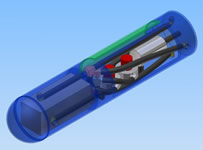
The PC brains behind the AUVT submarine is a VIA EPIA
Mini-ITX mainboard, providing the key processing power for the
necessary visual recognition software programs while
minimizing the battery drain with the EPIA's low power VIA C3
processor.
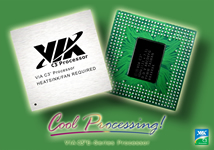
AUVT has grown into a team of nearly 50 students of
several backgrounds, including Aerospace, Ocean, Electrical,
Computer, Mechanical, and Industrial Engineers, Computer
Scientists, and Business and Marketing students all
interacting to fully design and compete in a collegiate
competition sponsored by the Office of Naval Research (ONR)
and the Association for Unmanned Vehicle Systems International
(AUVSI).
Justin Hayes is the team leader for AUVT. In an
interview on VIA ARENA he gives excellent insight into the
challenges faced of coordinating a project that requires
cooperation between a variety of fields and how they came to
chose VIA's EPIA Mini-ITX for their submarine.
Read the Justin Hayes interview here:
http://www.viaarena.com/?PageID=317
For more information about team AUVT be sure to visit
their website:
http://www.fbox.vt.edu/eng/aero/AUVT/index.html
Other VIA Robotics Projects:
Department of Industrial Electronics at the
University of Minho in Portugal
-A team of robots
competing in Robotica 2003 in Lisbon.
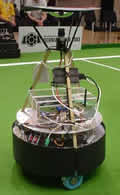
|
The "DevilCat"
-Chris Kern's home made robot
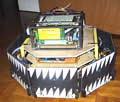
|
Mobile Robotics
-VIA is a proud sponsor
of the Mobile Robotics website. A community
website for sharing resources and information about
robotics.

|
For more information on the VIA Robotics Initiative
please contact TimothyJBrown@via.com.tw.
|
 我要赚赏金打赏帖
我要赚赏金打赏帖












